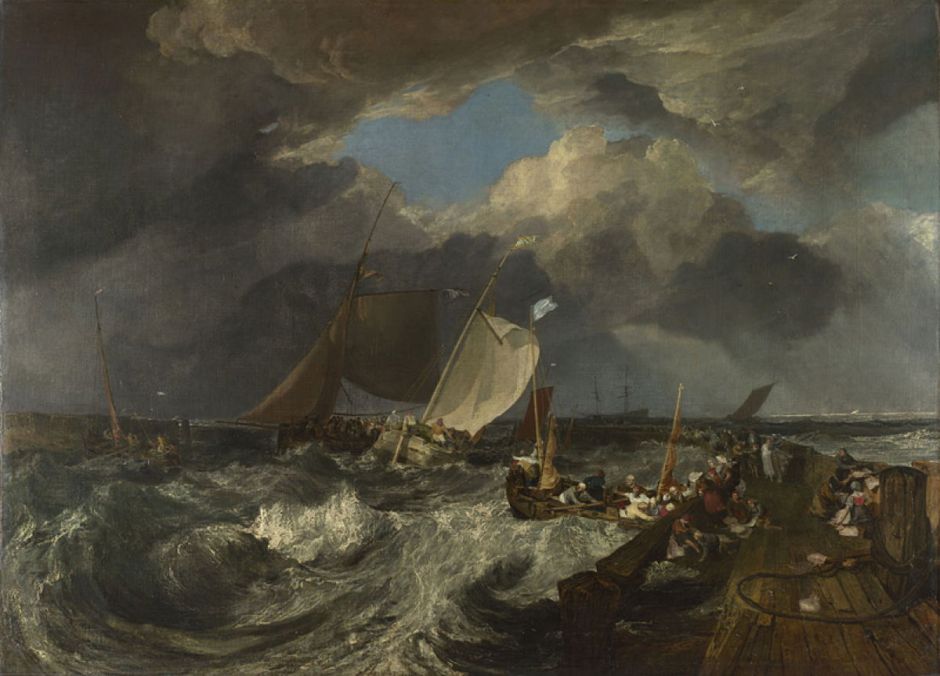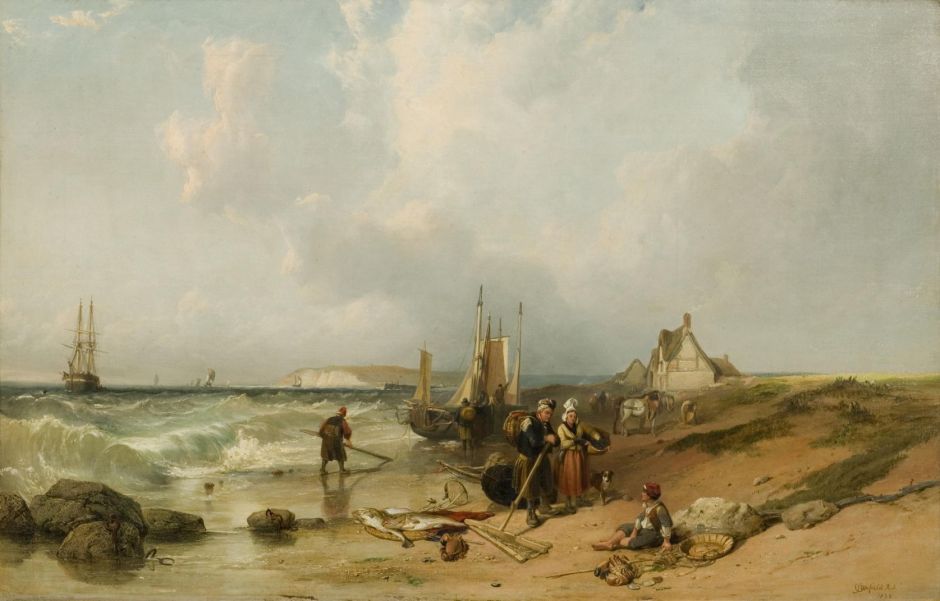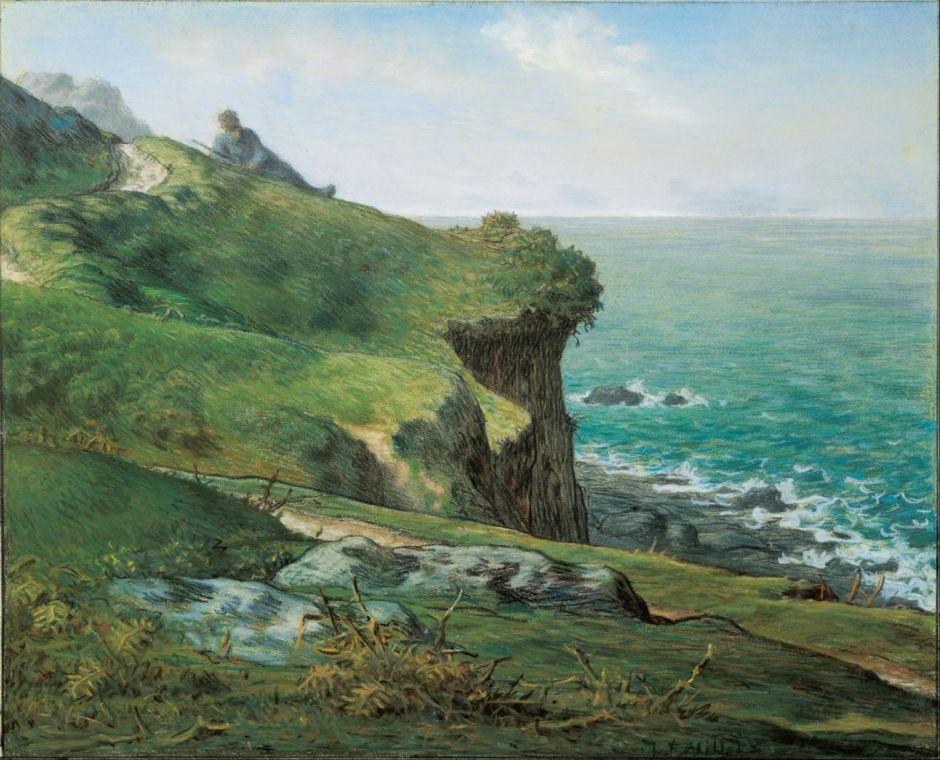In yesterday’s article, we made our way eastwards along the southern coast of England, starting near Land’s End, and ending up at the white cliffs of Dover, ready to cross over to make the return trip along the north coast of France.

In 1802, during the lull between the French Revolution and the Napoleonic Wars, JMW Turner turned his attentions to the European continent. He crossed from Dover to Calais, the shortest route but often a rough one, and caught the sea when it was less comfortable. He painted the scene of his arrival in France in Calais Pier, with French Poissards preparing for Sea: an English Packet arriving (1803), in which the French fishermen seem happy to head out in search of a catch.
Although Turner uses the light with great skill, and illuminates the sail of one of the vessels leaving, when shown at the Royal Academy opinion was that the foreground was unfinished, and it was not well received.

Clarkson Stanfield also crossed the Channel, and his Sands near Boulogne (1838) shows a catch of fish being landed on this low and flat section of the French coast.

A couple of years after he exhibited at the First Impressionist Exhibition, Ludovic-Napoléon Lepic painted this Fishing Boat Entering Berck, showing the chaos among and damage to a fleet of small fishing boats as they struggle with heavy seas off the fishing port of Berck, further along the Channel coast. The vessel closest has sheared its bowsprit, is at risk of sinking by the stern, and its sails are ragged. Others also appear in quite serious difficulties.

Turner toured northern France painting coastal scenes, including the bustling Harbour of Dieppe, which he made in about 1826 from a series of sketches and studies.

A few years later, Eugène Isabey caught The Town and Harbour of Dieppe on a greyer day in 1842, with laundresses in the foreground seizing a break between showers to get on with their work.
The next major port to the west is Le Havre, where Claude Monet grew up. Not far from there is the village and famous cliff at Étretat, which became hugely popular with artists in the middle of the nineteenth century.

The first pre-Impressionist painter to have shown particularly interest in Étretat Harbour was Johan Jongkind, who painted it in 1852, when it was still small and undiscovered.

Thirty years later, at the height of Impressionism, Monet painted this Stormy Sea at Étretat (1883) from the beach directly in front of the village, and it proved a prototype for a small series.

Monet had earlier painted these fishing boats in fairer conditions, on the other side of the mouth of the River Seine, in The Beach at Sainte-Adresse (1867).

Monet had moved to Le Havre when he was only four years old, and it was there that he grew up and started his career as a painter. He made The Mouth of the Seine, Honfleur in 1865, when he was still working in realist style, although even at this stage the painterly approach of Boudin is apparent in his brushwork.
Although the small ports along much of the Normandy coast have been popular with a succession of landscape artists, our next stop is Gréville, just to the west of Cherbourg, at the tip of the peninsula which pokes up towards the Isle of Wight on the opposite coast.

Jean-François Millet painted occasional landscapes, particularly of the coastline near his home village. The Cliffs of Gréville (1871) is a fine pastel depiction which surprises by its unusual scaling and distance effects. At first sight, the more distant clifftop seems quite far away, but the man recumbent on the skyline establishes that it is in fact quite close to the viewer.

The French Mont Saint Michel nestles on the western side of the base of the Cherbourg Peninsula. It’s only appropriate that this 1836 engraving should be taken from Clarkson Stanfield’s painting of St Michael’s Mount, Normandy, from the West (1836).
Just before reaching the next major port to the west, Saint-Malo, is the oyster fishery of Cancale.

I don’t know whether the young John Singer Sargent was there for the oysters or his art, but his painting of Fishing for Oysters at Cancale (1878) was one of his early successes, made at a time when he was starting to paint major portraits, and the year before he first visited Spain.
Although the coast of Brittany has attracted almost every landscape painter in Europe since the middle of the nineteenth century, almost all of them visited and painted locations to the south of Brest, in the northern arm of the Bay of Biscay. Few made the boat journey out to Ushant, or Ouessant, which stands solitary guarding the Western Approaches from the big seas of the North Atlantic.

Henry Moret’s Cliffs at Ouessant (1902) shows this small and rugged island with a population of less than a thousand. Its major industry at the time was fishing, and harvested seaweed was used as a fertiliser to support its limited subsistence farming.

